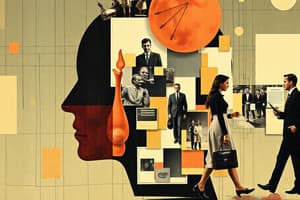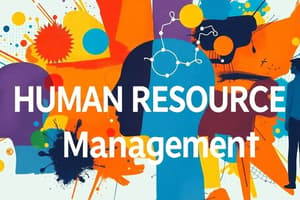Podcast
Questions and Answers
What is one primary focus of an HR strategy?
What is one primary focus of an HR strategy?
- Reducing hiring processes to minimum
- Maximizing profit margins continuously
- Strategic alignment of HR topics (correct)
- Enhancing employee satisfaction at all costs
Which factor is NOT listed as a critical business challenge for CEOs?
Which factor is NOT listed as a critical business challenge for CEOs?
- Changing consumer segments
- Increasing employee training costs (correct)
- Decreasing purchase power
- Technological advancements
What is emphasized as an emerging challenge in the business landscape?
What is emphasized as an emerging challenge in the business landscape?
- Increasing market monopolies
- Growing resource scarcity (correct)
- Decreasing consumer preferences
- Stable market growth
What role does the structural and cultural context play in HR strategies?
What role does the structural and cultural context play in HR strategies?
Which of the following factors is linked to changing consumer behavior?
Which of the following factors is linked to changing consumer behavior?
What primary challenge relates to low-cost suppliers?
What primary challenge relates to low-cost suppliers?
How does digitalization impact HR strategy?
How does digitalization impact HR strategy?
What is one challenge posed by global competition?
What is one challenge posed by global competition?
What characterizes a KEY-Function in a company?
What characterizes a KEY-Function in a company?
Which approach focuses on the workforce needs of a business?
Which approach focuses on the workforce needs of a business?
What is a key feature of the Soft HRM approach?
What is a key feature of the Soft HRM approach?
What kind of organizational structure is often associated with the HARD Approach?
What kind of organizational structure is often associated with the HARD Approach?
In a Soft HRM approach, what is preferable regarding employee motivation?
In a Soft HRM approach, what is preferable regarding employee motivation?
Which leadership style does the Soft Approach typically support?
Which leadership style does the Soft Approach typically support?
Which area is NOT included in the content outline for the lecture on HRM?
Which area is NOT included in the content outline for the lecture on HRM?
What is an essential goal of the Soft HRM approach?
What is an essential goal of the Soft HRM approach?
Which component is included in the HR landscape as per the provided content?
Which component is included in the HR landscape as per the provided content?
Which of the following is NOT a characteristic of the HARD Approach?
Which of the following is NOT a characteristic of the HARD Approach?
What is one of the expectations from HR mentioned for managers?
What is one of the expectations from HR mentioned for managers?
Which of the following is a major focus within Talent Management?
Which of the following is a major focus within Talent Management?
What is the main orientation of operational HRM?
What is the main orientation of operational HRM?
Which function is NOT part of operational HRM?
Which function is NOT part of operational HRM?
How is strategic HRM (SHRM) primarily characterized?
How is strategic HRM (SHRM) primarily characterized?
In the context of the employee life cycle, which of the following is included?
In the context of the employee life cycle, which of the following is included?
What is a key focus of contemporary HR roles as indicated in the content?
What is a key focus of contemporary HR roles as indicated in the content?
What does the concept of 'HR as Change Agent' imply?
What does the concept of 'HR as Change Agent' imply?
How does strategic HRM relate to company targets?
How does strategic HRM relate to company targets?
Which of the following roles does strategic HRM encompass?
Which of the following roles does strategic HRM encompass?
Which statement reflects the shift from traditional to future HR?
Which statement reflects the shift from traditional to future HR?
What is the categorization in HR that reflects improvement towards business efficiency?
What is the categorization in HR that reflects improvement towards business efficiency?
What is the primary focus of the HR Triangle identified by Trost?
What is the primary focus of the HR Triangle identified by Trost?
Which of the following reflects a key aspect of developing an HR strategy according to Trost's models?
Which of the following reflects a key aspect of developing an HR strategy according to Trost's models?
In the context of HR, what does 'people-centered enablement' emphasize?
In the context of HR, what does 'people-centered enablement' emphasize?
How does Trost describe the interaction of stability and agility within HR strategies?
How does Trost describe the interaction of stability and agility within HR strategies?
What is an example of a fundamental strategic question for a company?
What is an example of a fundamental strategic question for a company?
What does the 'attitude of the founder' refer to in the HR framework presented by Trost?
What does the 'attitude of the founder' refer to in the HR framework presented by Trost?
Which of the following is NOT a component related to institutionalization in HR strategy?
Which of the following is NOT a component related to institutionalization in HR strategy?
What best describes the aim of strategic management systems within an HR context?
What best describes the aim of strategic management systems within an HR context?
What is a key requirement for future employees mentioned in the discussion?
What is a key requirement for future employees mentioned in the discussion?
Which megatrend is associated with the need to manage strategic changes in HRM?
Which megatrend is associated with the need to manage strategic changes in HRM?
Which aspect is NOT typically addressed by modern HRM according to the content?
Which aspect is NOT typically addressed by modern HRM according to the content?
What challenge does HR face in the context of talent acquisition as per the given content?
What challenge does HR face in the context of talent acquisition as per the given content?
Which of the following is mentioned as a strategy for employee retention?
Which of the following is mentioned as a strategy for employee retention?
According to the content, why is supporting diversity important in HRM?
According to the content, why is supporting diversity important in HRM?
Which megatrend addresses the importance of an aging workforce?
Which megatrend addresses the importance of an aging workforce?
What role does HR play in the context of global competition?
What role does HR play in the context of global competition?
How does lifelong learning benefit employees according to HRM strategies?
How does lifelong learning benefit employees according to HRM strategies?
Which of the following functions is part of the HR landscape mentioned?
Which of the following functions is part of the HR landscape mentioned?
Flashcards
Human Resource Management (HRM)
Human Resource Management (HRM)
The process of managing people within an organization. It involves attracting, developing, motivating, and retaining employees to achieve organizational goals.
HR Strategy
HR Strategy
Developing a plan to address HR needs and align with organizational goals. Examples include attracting talent, improving employee performance, and managing staff diversity.
Employer Branding
Employer Branding
Creating a positive value perception of your company as an employer, attracting talents, and engaging applicants. This involves marketing your company's culture, values, and career opportunities.
Candidate Selection
Candidate Selection
Signup and view all the flashcards
Diversity Management
Diversity Management
Signup and view all the flashcards
Talent Management
Talent Management
Signup and view all the flashcards
Talent Development
Talent Development
Signup and view all the flashcards
Talent Retention
Talent Retention
Signup and view all the flashcards
Megatrends in HRM
Megatrends in HRM
Signup and view all the flashcards
Demographic Consequences in HRM
Demographic Consequences in HRM
Signup and view all the flashcards
What is Strategic HRM (SHRM)?
What is Strategic HRM (SHRM)?
Signup and view all the flashcards
What is Operational HRM?
What is Operational HRM?
Signup and view all the flashcards
How does SHRM integrate with business strategy?
How does SHRM integrate with business strategy?
Signup and view all the flashcards
What is Personnel Planning?
What is Personnel Planning?
Signup and view all the flashcards
What is the Employee Life Cycle?
What is the Employee Life Cycle?
Signup and view all the flashcards
What is Personnel Development?
What is Personnel Development?
Signup and view all the flashcards
What is Personnel Management?
What is Personnel Management?
Signup and view all the flashcards
What is Personnel Support?
What is Personnel Support?
Signup and view all the flashcards
What is Personnel Administration?
What is Personnel Administration?
Signup and view all the flashcards
What is Personnel Controlling?
What is Personnel Controlling?
Signup and view all the flashcards
HR Triangle
HR Triangle
Signup and view all the flashcards
Institutionalization-centered HR Strategy
Institutionalization-centered HR Strategy
Signup and view all the flashcards
Network-centered HR Strategy
Network-centered HR Strategy
Signup and view all the flashcards
People-centered HR Strategy
People-centered HR Strategy
Signup and view all the flashcards
Strategic HR
Strategic HR
Signup and view all the flashcards
Fundamental Strategic Questions
Fundamental Strategic Questions
Signup and view all the flashcards
HR Strategy Development
HR Strategy Development
Signup and view all the flashcards
Analytical Skills for HR
Analytical Skills for HR
Signup and view all the flashcards
Strategic Definition of Resources
Strategic Definition of Resources
Signup and view all the flashcards
Critical Business Challenges
Critical Business Challenges
Signup and view all the flashcards
Decreasing Purchase Power
Decreasing Purchase Power
Signup and view all the flashcards
Digitization
Digitization
Signup and view all the flashcards
Growing Resource Scarcity
Growing Resource Scarcity
Signup and view all the flashcards
Emerging Business Models
Emerging Business Models
Signup and view all the flashcards
Global Competition
Global Competition
Signup and view all the flashcards
Political Uncertainty
Political Uncertainty
Signup and view all the flashcards
What is a 'key function'?
What is a 'key function'?
Signup and view all the flashcards
Why are key functions important?
Why are key functions important?
Signup and view all the flashcards
What does 'best' recruitment and development mean for key functions?
What does 'best' recruitment and development mean for key functions?
Signup and view all the flashcards
What is the cost consideration for key functions?
What is the cost consideration for key functions?
Signup and view all the flashcards
Where are key functions on the organizational radar?
Where are key functions on the organizational radar?
Signup and view all the flashcards
What is the 'hard HRM' approach?
What is the 'hard HRM' approach?
Signup and view all the flashcards
What is the 'soft HRM' approach?
What is the 'soft HRM' approach?
Signup and view all the flashcards
Which HRM approach is more common today?
Which HRM approach is more common today?
Signup and view all the flashcards
Study Notes
Human Resource Management (HRM) Basics
- HRM is a planned and controlled activity of an organization to build and maintain the relationship between the organization and its employees. This relationship aims to fulfill business objectives and employee expectations.
- HRM encompasses all processes, from defining a strategy to operational implementation and control.
- HRM often involves key aspects like legal, psychological, sociological, and educational considerations related to the people being managed.
Assessment Scheme
- The total assessment score is 100 points.
- Case studies (group work) contribute 60 points, drawn from 6 topics taught in the lecture.
- A final multiple-choice online test (Moodle Quiz) contributes 40 points, scheduled on January 13th, 2025.
- Case study evaluation criteria: no copying from presentation slides, relevant answers, realistic proposals/ideas, and correct grammar/spelling are important.
HRM Landscape
- HRM involves strategy & planning, talent management & development, competency management, change management, diversity, compensation & benefits, retention, and HR organization & controlling, and HR-IT.
- HRM functions are interconnected.
Content for Lecture
- The lecture covers introduction to HRM, defining HR, and HRM strategy, HR organization, workforce planning, talent acquisition, employer branding, candidate selection, diversity management, talent management, talent development & retention.
Warming Up
- The session started with prompting students about their initial understanding and expectations related to Human Resources (HR).
Definition of HRM
- HRM is a set of planned and controlled activities that an organisation undertakes to establish and maintain a suitable connection between employees and the organization so as to meet both business objectives and employee expectations.
- HRM involves processes from developing a strategy to the operational roll-out and control.
- Important aspects of HRM include legal, psychological, sociological, and educational considerations
Targets of HRM
- HRM targets economic and social goals, but these can sometimes be conflicting.
- The goal is to optimize the intersection between both areas.
Economic Targets of HRM
- Reducing people costs.
- Reducing absence and turnover.
- Incorporating improvement processes.
- Increasing employee flexibility.
- Optimizing production factors.
Social Targets of HRM
- High income.
- Social security
- Development and self-actualization at the workplace.
- Good employment conditions.
- Agreeable working atmosphere
- Learning opportunities
- Career opportunities
- Social contacts
- Participative leadership
- Social status
- Work-life balance
- Unity of family and work life
- Employee participation
- Flexible working times
- Social benefits
- Company pension schemes
Operational vs. Strategic HRM
- Operational HRM is focused on employees/jobs, individual personnel, mainly short-term oriented, and has a high degree of detail.
- Strategic HRM is an abstraction from singular employees and jobs. Its focus is on the company's overall targets and is part of the company strategy; it involves integration of partial operational HR functions (cross-functional), and usually includes a longer planning horizon
Sub-Functions of Operational HRM
- HR policies (strategy based).
- Personnel planning.
- Personnel recruitment.
- Personnel deployment.
- Personnel management (off-the-job activities).
- Personnel support.
- Personnel administration.
- Personnel controlling
Employee Life Cycle
- Employer Branding, Recruitment, Engagement & Retention, performance management, Talent and Deployment (development and onboarding of employees within an organization), Organizational Culture, and People Strategy are part of the employee life cycle.
The HR Journey at a Glance
- HR's evolution over time, highlighting key milestones (e.g., 2nd Industrial Revolution, World Wars, and Globalization) and corresponding shifts in focus/structures
- Evolution of HR functions over time; early HR was centered around welfare, evolved to managing labor, personnel, and human resources effectively, finally to a strategic partner role focused on adding value to the business.
Development of HRM
- The role of HR has changed over time. This can be from the ‘Welfare officer’ of the earlier days, developing to the ‘Personnel Management’, and evolving even further to becoming a key part of the ‘Strategic functions’ now. HR’s role in collective bargaining, policy formation, and management
From Traditional to Future HRM
- Traditional HR was heavily focused on administration, with strategy, consulting, and support as minor components. Future HR prioritizes all these components.
Context for HRM
- The context of HR involves understanding disruption, digital transformation, and securing future success, emphasizing change, and highlighting the need for business and societal relevance in HR methodologies
Discussion in Small Groups
- Discussions should center around key changes, challenges for HR today, requirements of future employees, and implications on the HR function.
Megatrends Determining Future HRM Challenges
- Innovation (acquiring and rewarding right talent).
- Demography (leveraging employee potential, supporting diversity, and building successors).
- Globalization (knowledge retention and attraction, and attractive working conditions).
- Web 2.0 (managing changes and using latest technologies).
- Value change (using suitable HR technologies and policies).
Generational Changes in Values, Expectations and Goals
Megatrends in HRM, Demographic Consequences
- Generation development: organizational knowledge transfer between senior and junior employees.
- Qualification: focusing on workforce and life long learning.
- Retention: securing employability throughout life cycles.
- Extension: integration of varied career models despite age.
- Integration/Talent Management: integration of immigrants and appropriate talent management techniques.
- Adaptation: adaptability of working conditions in various life phases/health
HRM Landscape - Updated
- The diagram shows Talent Acquisition, Change Management, Candidate Selection, HR Organization, Strategy, and Planning, Talent Development, and Compensation and Benefits.
- All of these aspects are interconnected and contribute to the overall HRM Landscape.
Key Questions
- Relation between company strategy and HR strategy.
- Key company functions which are of the highest priority in the HR strategy.
Definition of HR Strategy
- A company's HR strategy encompasses all people-related approaches that address strategic business challenges and purpose. It aims to enhance the company's competitive advantage.
- Moreover, the HR strategy outlines how various critical approaches synchronize with the organisation's structural and cultural context.
Company Development Within Two Hemispheres
- The diagram depicts a balance between hierarchical stability and agility in organizational development.
- Hierarchy and stability involve centralized responsibilities at top management levels.
- Agility and networks imply decentralized responsibilities, with shared responsibilities.
Types of HR within HR Triangle
- The visualization illustrates the diverse roles of HR professionals within an organization.
- The roles are categorized into central planning & control, hiring & compensation, attitude & structure, and strategic management aspects, respectively.
Group Discussion
Building a HR Strategy
- This is about identifying the people-related challenges/opportunities and connecting them to strategic HR topics and approaches. Key building blocks of an HR strategy include linking company strategy, people-related functions, and the strategic approach to HR.
Critical Business Challenges
- These are the key issues that frequently occupy a CEO's attention. Topics covered include decreasing purchasing power, changing customer preferences, technologies, shifting consumer behavior, emerging aggressive players, globalization, political uncertainty, and new business models.
Competitive Advantage
- Companies achieve competitive advantage by offering innovative products, high-quality services, advanced technology, better products, broader market access, and strategic communication.
Potential Key People-Related Challenges
- Difficulties in filling key/expert positions.
- Bottlenecks in filling positions, leading to disruptions.
- Difficulty in leveraging employee potential.
- Ensuring broad-based employability.
- Keeping high levels of engagement.
- Managing differences between generations in the workforce.
Potential HR Topics and Approaches
- Talent acquisition and selection
- Building Employer Branding
- Candidate sourcing and relation.
- Performance management and appraisal.
- Setting objectives.
- Talent Identification
- Developing learning and knowledge.
- Employee engagement & loyalty.
- Employee Retention
- Employee Compensation
- Reward strategy
Strategic Priorities
- Strategic priorities often cover Innovation, Branding, Price, Design, and Quality (identifying company examples in specific industries)
Function Importance
- Core and supportive functions are distinguished to identify the most crucial business areas, including product management, research and development, design, production planning, marketing, sales accounts management, services/support, quality management, IT control/accounting, human resources, facilities/security, and public relations/communications.
Company Strategy and HR Strategy
- HR strategy is closely related to and depends on the company's overall strategy.
- HR strategy considers employee competencies, motivation, values, priorities (e.g., competitive advantage) and business vision, for successful recruitment, employee development, communication, and exit processes (layoffs).
Critical Key and Bottleneck Functions
Bottleneck Functions
- Bottleneck functions are those in high demand that are difficult to fill due to current economic conditions or inadequate talent pools.
- There are fewer active job seekers than jobs available.
- Bottlenecks are often linked to a common pain (and/or need) across departments, locations, and subsidiaries within a company.
- For bottleneck functions, homogeneous target groups (e.g., engineers) are frequently used for selection purposes.
Key Functions
- A key function directly affects a company's competitiveness in the marketplace and is frequently a focus for the CEO. High performance in a key function generates significant/dramatic differences in the firm's success.
Example: Adidas
- Adidas' mission statement and guiding principles.
- Adidas's group strategy and strategic choices.
- Adidas's 3-pillar Human Resource strategy.
Dave Ulrich HR Model
- Components include strategic partners (defining strategies), change agents (renewing organizations), administrative experts (efficient infrastructure building), and employee champions (increasing employee commitment/capabilities).
Dave Ulrich HR Roles
- Strategic partner (Strategic HR Planning, HR as Business Partner, Culture & Image).
- Change agent (Staffing, Organizational Design, Performance Management, Training & Development).
- Administrative expert (Compensation, HR Information Systems, Compliance).
- Employee relations expert (Employee relations, Labor Relations, Compensation, diversity/EEO).
Three-Pillar Model of Modern HR Organization
- Includes a central coordination (HR business partner near to business), center of expertise (company-wide), and shared services center (delivery of standardized services) .
Studying That Suits You
Use AI to generate personalized quizzes and flashcards to suit your learning preferences.




